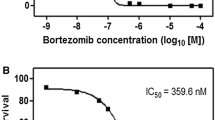Abstract
Multidrug resistant prostate cancer cell lines DU 0.03 and PC 0.03 were established from the parental prostate cancer cell lines DU145 and PC-3 respectively by stepwise selection in doxorubicin (DOX) from 0.001 to 0.03 μg/ml. As cells adapted to each concentration of DOX. the drug concentration was increased by 0.001 μg/ml. The chemosensitivity of each line was determined by growth inhibition assay. The DU 0.03 and PC 0.03 lines exhibit a 5–10-fold and 1.3–2.8-fold increase in resistance to anthracyclines, vinblastine (VLB) and mitozantrone (Mito), respectively. Verapamil (5 μM) partially reversed the resistance to the anthracycline and completely reversed the resistance to VLB and Mito. Drug kinetic studies measured by intracellular accumulation of 3H-daunorubicin demonstrated a 3 fold decrease in the level of intracellular 3H-daunorubicin in the PC 0.03 and DU 0.03 resistant lines compared with their respective parental line. This effect was partially reversed by 5 μM verapamil. The expression of MDR1 and MRP genes was analysed by Northern blotting and RT-PCR. P-glycoprotein (Pgp) and MRP protein were tested by immunocytochemistry staining using the monoclonal antibodies J-SB1. C219 and MRK16 (Pgp) and MRPm6 and MRPr1 (MRP). Neither Northern blot analysis nor the more sensitive RT-PCR demonstrated detectable MDR1 transcripts in any of the prostate cancer cell lines and the three Pgp monoclonal antibodies failed to reveal expression of Pgp.
A 2–4-fold increase in MRP1 mRNA levels in the drug resistant DU 0.03 and PC 0.03 lines were demonstrated by both Northern blotting and RT-PCR consistent with the findings observed after staining by the two specific monoclonal antibodies, MRPm6 and MRPr1. Southern blot analysis demonstrated a 2-fold increase in the MRP1 gene copy number in the PC 0.03 line but not in the DU 0.03 line, suggesting that the overexpression of the MRP gene was regulated at the level of transcription in the latter line. We conclude that MRP1 not MDR1 overexpression. contributes to acquired drug resistance in these two prostate cancer cell lines.
Similar content being viewed by others
Author information
Authors and Affiliations
Corresponding author
Rights and permissions
About this article
Cite this article
Zalcberg, J., Hu, X., Slater, A. et al. MRP1 not MDR1 gene expression is the predominant mechanism of acquired multidrug resistance in two prostate carcinoma cell lines. Prostate Cancer Prostatic Dis 3, 66–75 (2000). https://doi.org/10.1038/sj.pcan.4500394
Received:
Accepted:
Published:
Issue Date:
DOI: https://doi.org/10.1038/sj.pcan.4500394
- Springer Nature Limited
Keywords
We’re sorry, something doesn't seem to be working properly.
Please try refreshing the page. If that doesn't work, please contact support so we can address the problem.




